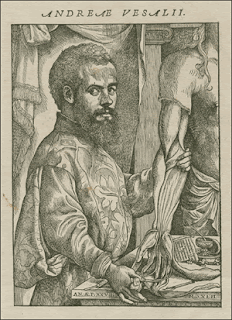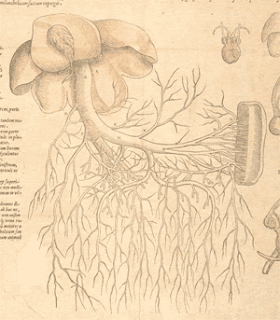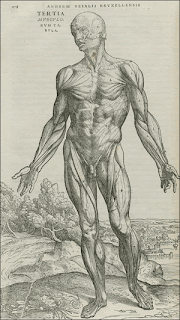Vesalius: Anatomist not Artist
 I'm in the process of reading the wonderfully witty book by Mary Roach called Stiff: The Curious Lives of Human Cadavers. Anyone who has had the opportunity to experience an anatomy lab should read this book. She gives a brief history of human anatomy and its most important contributors in the beginning of her book. With that said, I came across a passage about the famous anatomist, Andreas Vesalius. Mary states that
I'm in the process of reading the wonderfully witty book by Mary Roach called Stiff: The Curious Lives of Human Cadavers. Anyone who has had the opportunity to experience an anatomy lab should read this book. She gives a brief history of human anatomy and its most important contributors in the beginning of her book. With that said, I came across a passage about the famous anatomist, Andreas Vesalius. Mary states that
Vesalius produced a series of richly detailed anatomical plates and text called De Humani Corporis Fabrica, the most venerated anatomy book in history.
Those richly detailed anatomical plates are what in fact made the Fabrica such a monumental book in history. So, let's get one thing straight.Vesalius was an anatomist. He was not an artist.At least not to the extent of the illustrations found in his anatomical text. But, Vesalius was one of the first anatomists to use illustrations to accompany his teachings. I imagine he was the first to draw arteries in the form of lines and squiggles that looked more like roots or tree branches than actual organic arteries (check out his illustration of the hepatic portal vein and its tributaries below). It's what makes Vesalius so central to medical illustration, his union of image and text. Unfortunately, the artist or artists who worked on the Fabrica are most often left out of the picture.Yes Vesalilus produced the Fabrica, but who painstakingly illustrated it?While much is known about the life history of Vesalius, not much is known about the artist or artists who illustrated the Fabrica. It's unlikely that only one artist produced all of those fantastic illustrations.
It's what makes Vesalius so central to medical illustration, his union of image and text. Unfortunately, the artist or artists who worked on the Fabrica are most often left out of the picture.Yes Vesalilus produced the Fabrica, but who painstakingly illustrated it?While much is known about the life history of Vesalius, not much is known about the artist or artists who illustrated the Fabrica. It's unlikely that only one artist produced all of those fantastic illustrations. The book itself contains 83 anatomical plates with 420 separate illustrations, not to mention all of those little fanciful superfluous drawings that accompany the text (e.g. cherubs). The book was produced in 4 years and published in 1543. Even by today's standards, that's a lot of illustrations for one person to make in that amount of time. That's why it is believed that a team of artists worked on the Fabrica.Vesalius didn't disclose the name of his artists, so who could they have been? It's believed that the Renaissance painter, Titian, assisted by students like Jan Stephan van Calcar and Domenico Campagnola produced the illustrations in the Fabrica.Jan van Calcar did the illustrations for Vesalius' earlier anatomical publication entitled Tabulae Anatomicae Sex, or Six Anatomical Plates, published in 1538. The success of these anatomical plates would suggest that Vesalius would use the same artist for his Fabrica.Another famous anatomist, Bernhard Siegfried Albinus, produced the famous Tabulae sceleti et musculorum corporis humani, published in 1747. The Tabulae had only one artist, Jan Wandelaar.The bottom line here is that behind every great anatomist in history was a great, highly skilled illustrator. These pivotal anatomical texts could not have changed anatomical history the way they did without their inspiring and captivating illustrations.Today, the anatomist and illustrator are combined into one functional designer, the medical illustrator. One that understands the anatomy and the techniques to communicate and portray that anatomy in an educational way.So let's not forget to give credit to those illustrators throughout history who are oftentimes overlooked and under appreciated.
The book itself contains 83 anatomical plates with 420 separate illustrations, not to mention all of those little fanciful superfluous drawings that accompany the text (e.g. cherubs). The book was produced in 4 years and published in 1543. Even by today's standards, that's a lot of illustrations for one person to make in that amount of time. That's why it is believed that a team of artists worked on the Fabrica.Vesalius didn't disclose the name of his artists, so who could they have been? It's believed that the Renaissance painter, Titian, assisted by students like Jan Stephan van Calcar and Domenico Campagnola produced the illustrations in the Fabrica.Jan van Calcar did the illustrations for Vesalius' earlier anatomical publication entitled Tabulae Anatomicae Sex, or Six Anatomical Plates, published in 1538. The success of these anatomical plates would suggest that Vesalius would use the same artist for his Fabrica.Another famous anatomist, Bernhard Siegfried Albinus, produced the famous Tabulae sceleti et musculorum corporis humani, published in 1747. The Tabulae had only one artist, Jan Wandelaar.The bottom line here is that behind every great anatomist in history was a great, highly skilled illustrator. These pivotal anatomical texts could not have changed anatomical history the way they did without their inspiring and captivating illustrations.Today, the anatomist and illustrator are combined into one functional designer, the medical illustrator. One that understands the anatomy and the techniques to communicate and portray that anatomy in an educational way.So let's not forget to give credit to those illustrators throughout history who are oftentimes overlooked and under appreciated.
